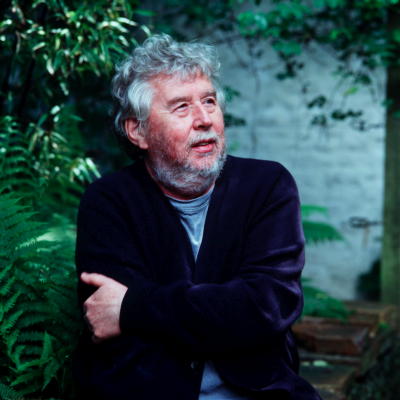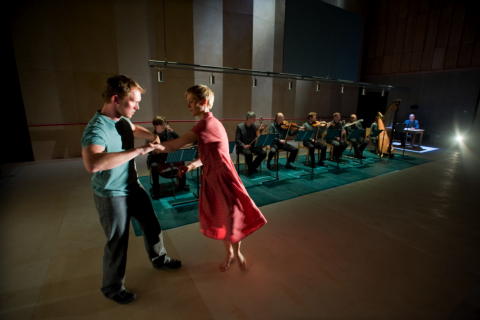|

Elemental Music
MALCOLM MILLER listens to
music-theatre works by Harrison Birtwistle
Ostensibly about lost love and melancholy, Harrison Birtwistle's latest music-theatre works Semper Dowland, semper dolens, theatre of melancholy and The Corridor, a scena about Orpheus and Eurydice, incisively explored central themes of postmodernism, the dialectic of past and present, and the dramatic highlighting of musical memory and time. The double bill received a stunning London première at the Queen Elizabeth Hall on Monday 6 July 2009, given by the London Sinfonietta, under the astute conducting of Ryan Wigglesworth, who was joined onstage by the composer to receive enthusiastic applause from a capacity audience that included many distinguished musicians. It was a joint commission from the London Sinfonietta, the South Bank Centre and the Aldeburgh Festival, where it was premièred on 12 June, as well as at the Bregenz Festival where it receives its première on 31 July and 1 August 2009.

Harrison Birtwistle. Photo © Hanya Chala / Arena PAL
|
The pairing of the two 'companion pieces' heightened the significance of each, in the Dowland adaptation adding an intriguing layer of meaning to the composer's earlier reworkings of the past such as his Machaut and Bach arrangements. While on the one hand the soundworld of Semper Dowland, semper dolens is far removed from Birtwistle's own unique contemporary idiom, both works shared the theme 'melancholy', separation and love, and from a purely sonorous level were linked by the ensemble of voice (the tenor Mark Padmore), harp and strings and wind ensemble (a five string consort in the first, three strings in the second, combined with clarinet / bass clarinet and flute / alto flute / piccolo). Each work gained significance and effect in the presence of the other, drawing one into a highly focused way of listening and into the intensity of expressive gestures of each style.
Semper Dowland, semper dolens is more than an arrangement -- it explores some of the aspects of structure and expression of Birtwistle's original works, such as the interweaving of instrumental movement and song found in, for instance, Pulse Shadows (where nine string quartet movements mingle with nine settings of Paul Celan), yet enhanced with a music theatrical richness. Here Dowland's Seven Passionate Pavanes are interwoven with Dowland songs organised in a type of 'dramatic narrative' about love's sorrow, ending in betrayal and grief.
Since, as the composer writes in his lucid programme notes, the seven Pavanes were themselves varied adaptations of a song, Lachrymae, the new version stays faithful to the principle of transformation already governing the pieces. There are long stretches in which the Dowland appears virtually 'untouched', yet which transforms into a wonderful anachronistic soundworld through just a few tiny changes, like a bowl of clear water which colours through the sprinkling of a minuscule grain of dye.
Both the start and ending are fragmented and extended with rests and thinning of texture, so that single lines follow each other building to the full cadence; meanwhile the inner voices are redistributed with some astonishing dissonance and false relations foregrounded through being in the upper or lower registers. At one point doublings at the fifth are introduced, and there are moments where the harmony is radically distorted, highlighting the disjunction of style. Similarly the instruments themselves either blend or clash against the Elizabethan style.
Dowland's viol consort is rescored on modern string instruments, yet played in such a way as to sound like viols, with little vibrato, some gut strings, and use of wooden (rather than plastic) mutes. Similarly the harp accompanying Mark Padmore retains but enhances the qualities of the original lute. Yet added to strings are two wind instruments, flute, and perhaps most shocking, clarinet, which retains its nineteenth century connotations, even when softened into a blended timbre. There are further radical effects when the wind instruments are extended to bass clarinet or alto flute, echoed in some high registral violin sounds.

A scene from Harrison Birtwistle's 'Semper Dowland, Semper dolens, theatre of melancholy' at the Aldeburgh Festival. Photo © Malcolm Watson
|
If Birtwistle describes his arrangement as a 'translation', the effect is more complex, as if only some words were translated and others retained in the original. One might fruitfully contrast Birtwistle's reworking of the past with other postmodernists such as Michael Nyman who both maintains the original intact, yet redistributes its elements to reflect a new guise. Birtwistle's approach is more subtle; we hear the process of Dowland's voice being transfigured, and experience the shifting time frame of centuries.
The anachronism is underlined by the modern music theatrical presentation, the theme of love's 'melancholy' enacted by the singer, Mark Padmore, seated at a writing desk, who appears like the poet imagining his lost love, observing the main romantic action portrayed by two ballet dancers. Padmore's highly nuanced and style sensitive expressive projection of the Dowland songs enthralled and captivated. The dancers, Helka Kaski and Thom Rackett, traced smoothly rhythmic movements contrasted by vigorous, abrupt gestures which both told a story and acted as an allegory for the dissonance and consonance of renaissance harmony and the dislocation of style.
The harp tenor relationship of the Dowland is transformed in The Corridor, a potent scena from the Orpheus and Eurydice myth to a libretto by David Harsent. Here Mark Padmore's Orpheus, introduced mainly by strident harp arpeggiations, rather like operatic recitative, formed a clear connection to the earlier Dowland piece. His duets and dialogues with the soprano Elizabeth Atherton's resilient Eurydice were vivid and gripping. The substantial piece displayed Birtwistle's characteristic dramatic impetus, with the six piece string, wind and harp ensemble brilliantly deployed to produce gritty and dense yet also translucent, lyrical and beguilingly harmonious textures.

A scene from Harrison Birtwistle's 'The Corridor' at the Aldeburgh Festival. Photo © Malcolm Watson
|
The scena expands the moment when Orpheus looks back at Eurydice and as a result loses her forever. At first the music is very dramatic and incisive, with quickfire exchanges. The high ranging vocal lines interweave with electricity, both as they initially argue, and then as she tries unsuccessfully to reach him and the light of day, returning each time to darkness. The vocal lines are widely contoured, especially those for Eurydice, except where contrasted, in several of the eight sections, by a type of sprechgesang, where Eurydice comments in a spoken voice, as if she is dead to the light of song.
A shortcoming to this melodrama where the singer interacts with the instrumentalists, who symbolise the 'Shades', was a slackening of intensity, with some dance-like textures lightening the mood yet too fragmentary; Eurydice's role in relation to Orpheus was more highly charged, providing climactic passion from which the final fading of energy and light rounded the work off with focus and poetry. While the protagonists' striving for light was enhanced throughout by Paul Pyant's red-glowed lighting, it was Birtwistle's elemental music, instrumental as well as vocal, even more than the staging, that propelled the drama to its emotive and poignant resolution.
Copyright © 15 July 2009
Malcolm Miller,
London UK

HARRISON BIRTWISTLE LONDON QUEEN ELIZABETH HALL BREGENZ FESTIVAL MARK PADMORE UNITED KINGDOM
|

